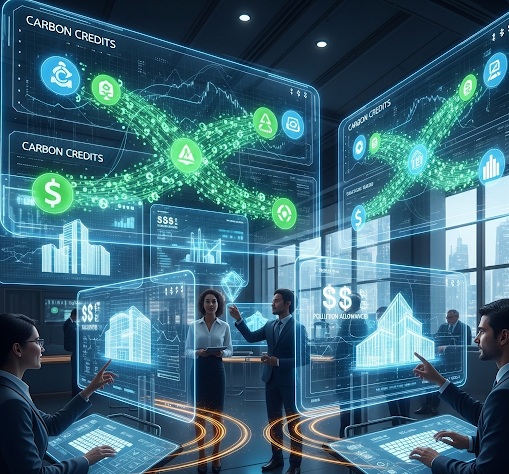
The Carbon Trading
Economists have incentivized companies and economies to reduce greenhouse gas emissions by creating a financial value for the right to pollute. They’ve converted this into a carbon market, a system that makes pollution a tradable commodity. The underlying principle is to leverage market forces to find the most cost-effective way to reduce emissions across an entire economy.
Here’s the simplified, professional breakdown of the process and flow:
1. The “Externality” Problem and the Economic Solution
Traditionally, pollution was considered a negative externality, meaning it was a cost to society (e.g., climate change, health issues) that wasn’t borne by the polluting company. This meant there was no economic incentive for a company to reduce its emissions. Economists addressed this by creating a mechanism to “internalize” this cost, making companies financially accountable for their pollution. The primary way they’ve done this is through carbon pricing, either with a tax or a market.
2. The “Cap-and-Trade” Framework
The most common approach is a “cap-and-trade” system. This is where the “right to pollute” becomes a valuable, tradable asset.
Setting the Cap: A government or regulatory body sets an economy-wide limit (cap) on total carbon emissions. This cap is the key to ensuring overall emissions are reduced. The cap is designed to decrease over time, tightening the supply of pollution rights and driving a need for cleaner technology.
Creating “Allowances”: The government issues a number of carbon allowances or credits, where each allowance permits the emission of one ton of CO2e. The total number of allowances issued is equal to the cap.
Initial Allocation: These allowances are then distributed to companies within the capped industries. They can be given away for free (often based on historical emissions) or, more efficiently, sold through an auction. This is the moment the “right to pollute” is officially monetized.
3. The Carbon Market and Tradable Commodity Flow
Once allowances are in the hands of companies, the market begins to function.
Trading: Companies that can reduce their emissions cheaply and efficiently will do so. They’ll then have a surplus of allowances. They can sell these extra allowances to other companies that find it more expensive to reduce their own emissions. This creates a market where allowances are bought and sold like any other commodity.
Incentivizing Efficiency: The market creates a powerful financial incentive. A company’s choice becomes simple:
Option A: Reduce Emissions. Invest in new, clean technology to lower emissions and then sell surplus allowances for a profit.
Option B: Buy Allowances. Continue polluting and buy allowances from other companies to cover the excess emissions.
The Price Signal: The price of a carbon allowance is determined by supply and demand. If the cap is tight and it’s difficult for many companies to reduce emissions, the price of allowances goes up. This high price acts as a strong price signal, telling companies that it’s becoming more expensive to pollute, thus making investments in clean technology more attractive.
Compliance and Retirement: At the end of a compliance period, each company must surrender enough allowances to cover their total emissions. The surrendered allowances are permanently retired from the market, ensuring that the overall cap is enforced.
This process transforms the atmosphere from a free resource into a limited asset with a tangible cost, compelling rational economic actors to make greener choices in their pursuit of profit.
